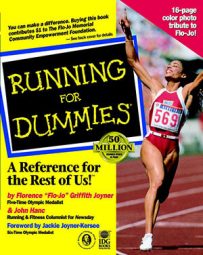The start line of a major marathon race is an exciting place to be. Crowds of spectators have gathered, and hundreds, maybe thousands, of runners are buzzing with anticipation. Balloons are released, rock music is playing, and announcements are blaring over the public address system.
It’s easy to get caught up in this atmosphere and to allow yourself to go out too fast. Remember what you’re there for: to finish and feel good about it. You’ll see lots of “hot dogs” go speeding by you. Don’t follow them. Chances are, you’ll see them again later, when their initial enthusiasm is tempered by the reality of 26.2 miles.
During the marathon
Keep these tips in mind during the marathon:
Focus on staying relaxed and in rhythm. And make sure that you stop and take fluids at every water stop, even if you don’t feel thirsty. Many marathons now have food and gel stops, as well. If you’ve tried these during your long runs, fine. If not, pass them by.
Break the race up into segments: 5-K, 5 miles, 10-K, 10 miles, half-marathon, 15 miles, 20 miles, 26.2. When you hit that first mile, don’t think “Okay, only 25.2 to go.” At each of the major checkpoints, think about how far you’ve come and how good you feel. Don’t worry about how fast you’re going. You should feel very comfortable for the first half of the race.
Remember that most successful marathons are run as negative splits, meaning that the second half is faster than the first. Even though your goal in your debut marathon is not a fast time, you should strive for the same approach, which requires careful pacing and keeping plenty in reserve. When in doubt, slow down, especially in the first 20 miles of the race.
Runners often say that a marathon begins at the 20-mile marker. No matter how well you’ve trained, the last 6.2 miles will probably be challenging. Now is the time to dig deep and to think about those long runs and the training and effort you’ve put into it. Focus on good, smooth running form.
Hang tough. The finish line’s in sight. At last! You’ve done it! When you cross the line, smile for the camera and keep walking.
Yes, we said camera. Most major marathons take a picture of every finisher. (Plus, you can be sure that friends and family will have their cameras and camcorders on hand as well.) The race photographer will send you a proof in the mail a few weeks after the race, and you can then buy as many glossy photos of yourself as you want.
After the race
Savor the moment and then get your baggage, change into some warm-ups, and keep taking fluids. A hot bath, a dip in a pool, some stretching, or a massage later will ease the soreness. So will 20 to 30 minutes of walking. Yes, one of the best things you can do after a marathon is walk — even if it’s later that day. And don’t run for the next week or so. Walking, cycling, and swimming are fine, but give your body a break from the pounding.
One last tip for race day. Have fun that night! You’ve earned it. You’re a marathoner.

